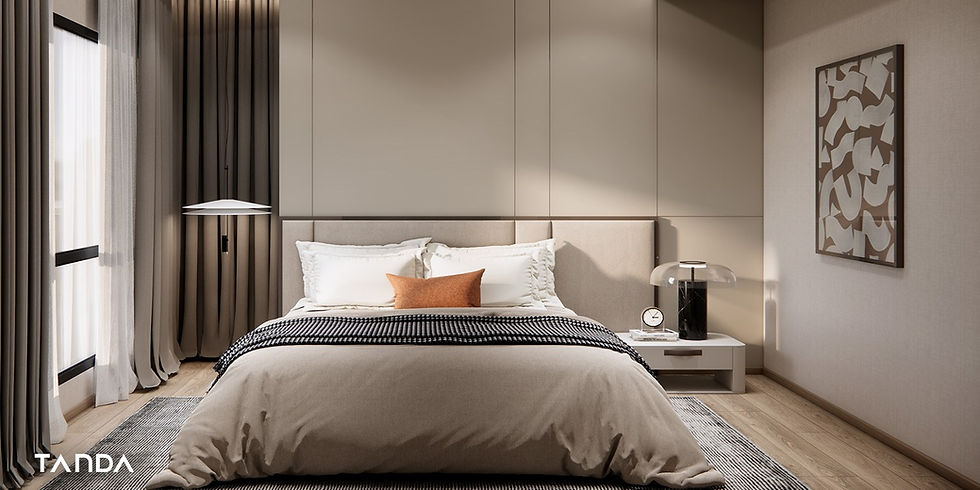Shophouse Renovation Ideas: Transform an Old Building into a Stylish, Fully Functional Space!
- Admin Tanda
- Sep 5
- 6 min read

Renovating a shophouse is not just about updating the existing structure—it’s about creating a fresh new identity for a space filled with history and memories.
Every change is inspired by the owner’s vision, blending functionality and aesthetics seamlessly.
Renovating a shophouse or townhouse brings an old home back to life, making it more practical and comfortable. From inspecting the property and upgrading its functions to choosing materials and managing the budget, this guide will show you how to turn an old shophouse into a vibrant, charming space full of new life.
Techniques for Inspecting a House Before Renovation for Safety
When renovating an old house or building, the first priority is to conduct a thorough inspection of its overall condition. A systematic check helps ensure a smooth and safe renovation process while minimizing risks.
Check the Structural Integrity
Start by examining the main structural elements, such as columns, beams, walls, and foundations, for cracks or damage that could affect stability. Consult an engineer or specialist to accurately assess strength and condition, preventing accidents or damage during renovation.
Assess Electrical and Plumbing Systems
Inspect wiring, electrical circuits, and plumbing to ensure they are in good condition, with no damage or risk of short circuits. Check the locations of outlets, faucets, and drainage pipes for potential upgrades or repairs. It’s recommended to hire professional electricians and plumbers for safety.
Measure and Plan the Space
Accurate measurements of each room and area are crucial for proper placement of furniture and decor. This step ensures efficiency, reduces mistakes, and helps avoid unnecessary costs.
Observe Ventilation and Lighting
Check whether the house has adequate ventilation and natural light from windows or openings. Proper airflow reduces the risk of mold, which can be a serious health hazard. Identify any damp areas and plan corrective measures to improve indoor air quality.
Inspect Floors and Flooring Materials
Examine floors for cracks or damage and evaluate whether existing flooring is still usable or needs replacement. Determine which areas can be preserved and which should be removed. This evaluation helps select suitable materials that will endure long-term use.
Make a List of Issues and Requirements
Gather all information from the inspection and compile it into a clear, detailed list. Every issue found should be documented to ensure proper fixes or improvements. This also helps communicate effectively with the renovation team, making the planning process more accurate and reducing errors during execution.
Take Photos and Record Notes
Photograph all key areas, especially spots that need repair, to have clear visual records. Images help both the renovation team and homeowners understand the current state accurately. This aids in design planning, cost estimation, and minimizes misunderstandings or miscommunication during the project.
Assess Technical Feasibility
Before starting renovation work, consult engineering and architectural experts to evaluate whether the proposed plan is technically feasible and meets safety standards. Check for limitations such as structural load capacity and existing utility systems.
Also, review relevant laws and regulations, such as building permits and zoning codes, to ensure the renovation project complies with legal requirements. This reduces potential legal issues and delays, ensuring a smoother, more efficient renovation process.

Renovation Ideas for Shophouses and Townhouses by Room – Full Functionality!
Renovating a shophouse or townhouse doesn’t have to be done all at once. You can focus on improving one room at a time, based on its function, to make the home both beautiful and fully functional.
1. Living Room
The living room should feel warm and inviting. Use light or natural tones for a comfortable atmosphere, and arrange furniture to maximize usable space. Add both natural and artificial lighting, such as floor lamps or stylish pendant lights.
Small decorative items like throw pillows, wall art, or air-purifying plants can add charm and liveliness to the space.
2. Kitchen
The kitchen should feel open and practical. Arrange countertops to make cooking convenient, such as an L-shaped or island layout to increase prep space. Use light colors like white or natural wood tones to make the area appear brighter and more spacious.
Install a range hood and proper ventilation to reduce odors and humidity. Adding organized storage and using easy-to-clean materials will keep the kitchen looking tidy and functional.
3. Bedroom
The bedroom should focus on relaxation and warmth, creating a restful retreat. Use soft or natural tones like white, cream, or wood colors, and keep furniture minimal to allow for better air circulation.
Add blackout curtains to aid sleep and choose decor that enhances coziness, such as pillows, blankets, or warm-toned lamps, creating a gentle and relaxing atmosphere ideal for rest.
4. Bathroom
The bathroom should focus on cleanliness and openness for a relaxing and practical space. Use light-colored tiles, such as white or cream, to make the room appear larger. Install a large mirror to add depth, and choose simple, modern fixtures. Plan separate wet and dry zones for convenience and easy maintenance.
Adding warm-toned lighting or natural light, along with small plants, can make the bathroom feel fresh and inviting.
5. Dining Area
The dining area should feel warm and welcoming. Use light tones like white, soft yellow, or natural wood to make the space appear bright and spacious. Arrange the table and chairs to fit the household size, ensuring comfort without crowding. Choose easy-to-clean wooden furniture and soft overhead lighting to create a relaxed atmosphere. Decorate with plants, flowers, or vases to add freshness and warmth to every meal.
6. Home Office
The home office should promote focus and creativity. Place the desk near a window for natural light, making the space bright and refreshing. Use warm or earth tones for a calming environment. Add small plants for a touch of greenery and stress relief.
Select simple, organized furniture to keep the space tidy and uncluttered. Include adequate task lighting to protect your eyes during nighttime or low-light work.
7. Storage Room
Organize the storage room efficiently for easy access. Install multi-level shelves to separate and store items neatly. Use boxes or bags with lids and labels for convenience and clarity. Open shelving or metal racks can make the space feel more open. Ensure sufficient lighting for safety.
In small areas, make use of under-stair or corner spaces with shelves or hidden drawers.
8. Balcony / Rooftop
Decorate balconies or rooftops as cozy relaxation spots. Use durable, easy-to-maintain flooring, like artificial grass or composite decking. Add greenery with potted plants, real or artificial, and place a suitably sized table and chairs for lounging or coffee breaks.
Install soft lighting for a pleasant evening ambiance. If space allows, vertical gardens can increase greenery without taking up much floor area, making the balcony or rooftop a lively and refreshing favorite spot.

Renovation Ideas for Shophouses: Modern Solutions for Every Lifestyle
Renovating a shophouse today is more than just repairing the old structure—it’s about creating a functional and stylish space that fits modern living. With various design approaches, a shophouse can be transformed into a comfortable home or workspace for everyone.
Minimalist Style
Minimalist renovations focus on simplicity and space efficiency. Light wood and neutral tones like white, gray, or cream create a bright, airy atmosphere. Built-in furniture maximizes usable space and keeps the area organized. Ideal for shophouses with limited space, this style is easy to maintain and always looks clean.
Loft Style
Loft-style renovations emphasize a raw, industrial look by exposing steel structures, beams, and original brick or concrete walls. Key materials include concrete, wood, and metal, with colors in gray, black, and brick tones. Open interiors with high ceilings (duplex style) and large windows reduce the feeling
of confinement, making the space versatile for offices, lounges, or creative areas while keeping a unique urban charm.
Scandinavian Style
Scandinavian renovations highlight simplicity and warmth, using natural materials like wood and linen. Neutral and earth tones (white, gray, beige) make small spaces feel bright and open. Designs often feature open, flowing layouts without steps, built-in storage, and natural light, creating a practical, cozy, and organized home.
Modern Style
Modern shophouse renovations focus on clean lines, functional layouts, and contemporary aesthetics. Materials include hardwood, glass, and metal, in white, gray, black, or earth tones. Spaces are kept open and light-filled, with built-in or multi-functional furniture that maximizes usability. This style suits the lifestyle of modern residents who value both design and functionality.
Tropical Style
Tropical renovations emphasize openness and a connection to nature. Common materials include natural wood, bamboo, ventilated brick blocks, and other eco-friendly elements. Colors highlight greens, blues, and earth tones. Open layouts, large potted plants, and greenery on balconies or rooftops improve air circulation, reduce heat, and create a refreshing, relaxing environment that enhances quality of life.
In Summary
Renovating shophouses and townhouses involves upgrading and transforming existing structures to meet modern living needs. This includes expanding usable space, updating electrical, plumbing, and ventilation systems for safety and efficiency, and choosing a design style that aligns with both personal taste and functional requirements.
The process should start with a thorough inspection of the existing structure to ensure safety and accurately estimate the budget. Design planning must focus on efficient use of space, flexibility, cost control, and selecting appropriate materials. A well-executed renovation not only enhances the home’s aesthetics but also improves quality of life and increases property value over time.
Looking for professionals to renovate your shophouse or townhouse?
Tanda Design Studio offers comprehensive interior design and renovation services with an experienced team that understands each client’s unique needs and preferences. We create functional, well-organized spaces that maximize limited areas, enhancing both living and working environments in a complete, professional process.







